
A percussion instrument is a musical instrument that is sounded by being struck or scraped by a beater including attached or enclosed beaters or rattles struck, scraped or rubbed by hand or struck against another similar instrument. Excluding zoomusicological instruments and the human voice, the percussion family is believed to include the oldest musical instruments. In spite of being a very common term to designate instruments, and to relate them to their players, the percussionists, percussion is not a systematic classificatory category of instruments, as described by the scientific field of organology. It is shown below that percussion instruments may belong to the organological classes of idiophone, membranophone, aerophone and cordophone.
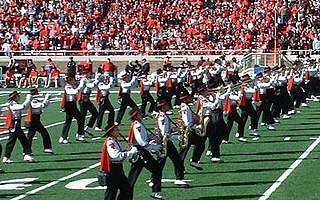
A marching band is a group of instrumental musicians who perform while marching, often for entertainment or competition. They are most popular in the United States, though not uncommon in other parts of the world. Instrumentation typically includes brass, woodwind, and percussion instruments. Most marching bands wear a uniform, often of a military style, that includes an associated organization's colors, name or symbol. Most high school marching bands, and some college marching bands, are accompanied by a color guard, a group of performers who add a visual interpretation to the music through the use of props, most often flags, rifles, and sabers.
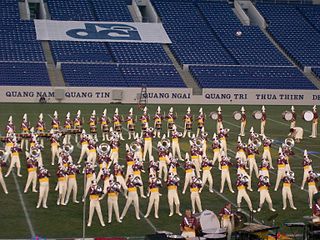
A modern drum and bugle corps is a musical marching unit consisting of brass instruments, percussion instruments, electronic instruments, and color guard. Typically operating as independent non-profit organizations, corps perform in competitions, parades, festivals, and other civic functions. Participants of all ages are represented within the corps activity, but the majority are between the ages of 13 and 22 and are members of corps within Drum Corps International or Drum Corps Associates.

Classic drum and bugle corps are musical ensembles that descended from military bugle and drum units returning from World War I and succeeding wars. Traditionally, drum and bugle corps served as signaling units as early as before the American Civil War, with these signaling units having descended in some fashion from ancient drum and fife corps. With the advent of the radio, bugle signaling units became obsolete and surplus equipment was sold to veteran organizations. These organizations formed drum and bugle corps of civilians and veterans, and the corps performed in community events and local celebrations. Over time, rivalries between corps emerged and the competitive drum and bugle corps circuit evolved.
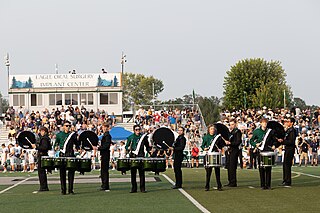
Marching percussion instruments are percussion instruments specially designed to be played while moving. This is achieved by attaching the drum(s) to a special harness worn by the drummer, although not all marching bands use such harnesses and instead use traditional baldrics to sling their drums.

An indoor percussion ensemble or indoor drumline is a type of marching ensemble consisting of battery and front ensemble instruments. It differs itself from a traditional percussion ensemble by not only on musical performance, but on theatrics and marching. Although most indoor percussion ensembles are affiliated with high schools, there are also many independent groups that draw participants from a large area and are independently funded. Independent groups typically start rehearsing in October, while high school groups typically start after their fall marching band season ends. Because of this, the activity is often called winter percussion or winterline.
A tenor drum is a membranophone without a snare. There are several types of tenor drums.
In the Philippines, a drum and lyre corps is a marching ensemble consisting of strictly percussion instruments and a color guard section. The drum and lyre corps originated in the Philippines, as an economical alternative to regular brass bands or a drum and bugle corps. The instrumentation of a drum and lyre corps consists of a typical marching band with the bell lyre section. The lyre sections consist of bell lyres, glockenspiels, as well as vibraphones and marimbas. During competitions, drum and lyre corps usually include a pit section which consists of the typical pit instruments used by drum and bugle corps.

The University of New Hampshire Wildcat Marching Band, is the official marching band of the University of New Hampshire. The WMB plays at home games of the Wildcat football team, typically one away game per season, the Dover and Salem band shows, and various parades across New England. The band has traditionally had an equal mix of music and non-music majors and claims to have an average GPA consistently above the university's average. The WMB usually marches 80 to 100 members, depending on the year. Its largest roster in the past decade was approximately 125.

Color guards or Flag corps are teams of performers who perform choreographed dances and routines with various equipment to enhance and interpret the music of a marching band or drum and bugle corps show. Color guard teams can be found in American colleges, universities, high schools, middle schools, and independent drum corps. They use various equipment including flags, fake rifles, and sabres, along with other props. Most Color Guard groups are of mixed gender but some may also be single gender.
Orchestral percussion refers to the various percussion instruments used in an orchestral setting. It may also refer to the act of playing such instruments in an orchestral style. Many music schools and conservatories offer training for musicians interested in developing their skills as orchestral percussionists. Typically, an orchestral percussionist does not specialize in one particular instrument. Although there is no exhaustive list of all instruments that an orchestral percussionist must be able to play, there are particular instruments that are frequently used in the orchestral repertoire. This includes timpani, snare drum, bass drum, xylophone, glockenspiel, triangle, and tambourine.

The Purdue "All-American" Marching Band is the marching band of Purdue University and performs at Purdue Boilermakers football games. The AAMB is also the official band of the Indianapolis 500 race, having held the position since 1919.

The Western Illinois University Marching Leathernecks is the marching band for Western Illinois University in Macomb, Illinois. The group was formed in 1904.

The University of Massachusetts Minuteman Marching Band (UMMB) is the marching band for the University of Massachusetts Amherst known for its drum corps style and nationally renowned percussion section. The Minuteman Band is also known for its use of dance routines, vocalists, electronics, and overall showmanship.

The Hawkeye Marching Band is the marching band for the University of Iowa. The band performs at all home Hawkeye football games at Kinnick Stadium in addition to other events. It is the largest and most visible musical ensemble at the university. The band was founded in 1881 as a military band, giving membership to both music students and members of the military. In 1990, the band was awarded the Louis Sudler Intercollegiate Marching Band Trophy, generally considered to be the most prestigious honor a collegiate marching band can receive.

Oregon State University Marching Band, ("OSUMB"), is the marching band of Oregon State University, known as the "Spirit and Sound of OSU." The band was established in 1891. It is one of the oldest bands in the Pac-12 and the primary athletic band at Oregon State. In addition to the Oregon State University Marching Band, other athletic bands include Basketball Band, Rhythm & Beavs, Rhythm & Beavs: Travel Band, the Away Game Pep Band, Alumni Band, Gymnastics Band, and Bar Band. All band members are required to participate in marching band before they may be eligible to participate in any of the other athletic bands Oregon State offers.

Daechwita is a genre of Korean traditional music consisting of military music played by wind and percussion instruments, generally performed while marching or as a static performance.

A Corps of Drums, sometimes known as a Fife and Drum Corps, Fifes and Drums or Field Music is a traditional European military music formation. In contrast to a military band, a Corps of Drums' primary role is communication. Historically, music was used as signaling device throughout the day for keeping the march tempo and delivering commands. Today, the primary role of a Corps of Drums is ceremonial, performing in parades and military ceremonies. Besides drums, this formation may contain a variety of instruments,including trumpets, bugles, and fifes.
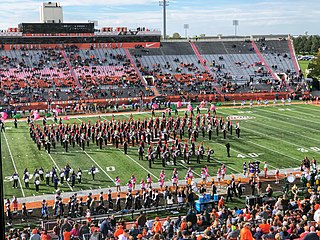
The Falcon Marching Band, known also as the FMB, is the marching band of Bowling Green State University. It features a symphonic sound and chair step marching. Under the direction of Jonathan “Jon” Waters, marching band is the largest student organization on campus. The band performs at all home football games, which are hosted in Doyt Perry Stadium as well as other various university functions.
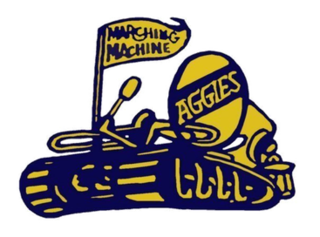
The Blue and Gold Marching Machine is the official marching band of North Carolina A&T State University. The Blue and Gold Marching Machine performs pre-game and halftime shows at all North Carolina A&T Aggies football home games and travels to most away games.

















